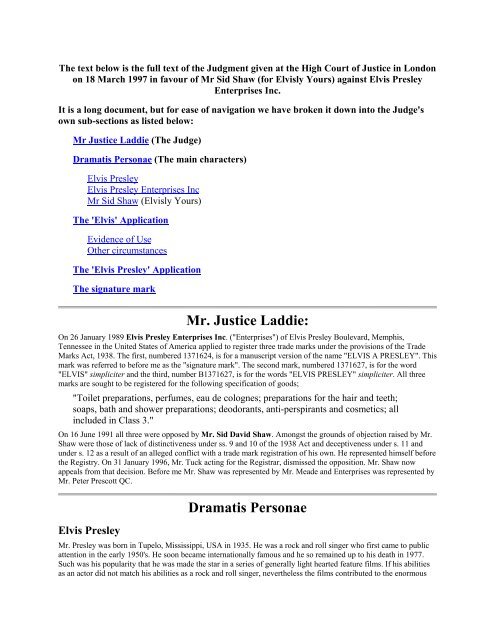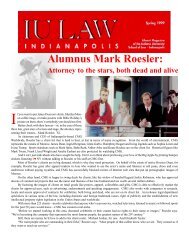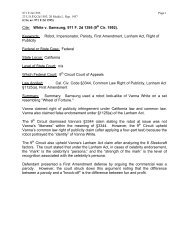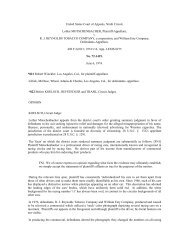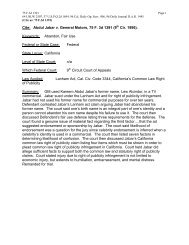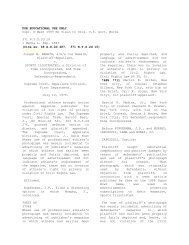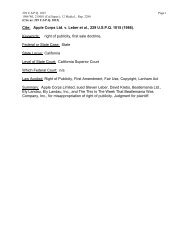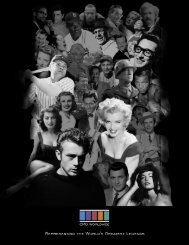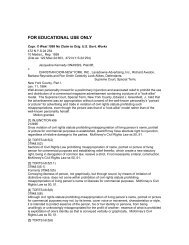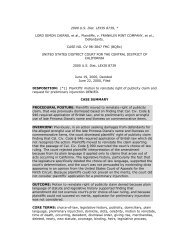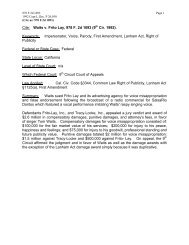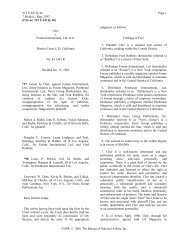Elvisly Yours v. Elvis Presley Enterprises Inc. - Mark Roesler
Elvisly Yours v. Elvis Presley Enterprises Inc. - Mark Roesler
Elvisly Yours v. Elvis Presley Enterprises Inc. - Mark Roesler
Create successful ePaper yourself
Turn your PDF publications into a flip-book with our unique Google optimized e-Paper software.
The text below is the full text of the Judgment given at the High Court of Justice in Londonon 18 March 1997 in favour of Mr Sid Shaw (for <strong><strong>Elvis</strong>ly</strong> <strong>Yours</strong>) against <strong>Elvis</strong> <strong>Presley</strong><strong>Enterprises</strong> <strong>Inc</strong>.It is a long document, but for ease of navigation we have broken it down into the Judge'sown sub-sections as listed below:Mr Justice Laddie (The Judge)Dramatis Personae (The main characters)<strong>Elvis</strong> <strong>Presley</strong><strong>Elvis</strong> <strong>Presley</strong> <strong>Enterprises</strong> <strong>Inc</strong>Mr Sid Shaw (<strong><strong>Elvis</strong>ly</strong> <strong>Yours</strong>)The '<strong>Elvis</strong>' ApplicationEvidence of UseOther circumstancesThe '<strong>Elvis</strong> <strong>Presley</strong>' ApplicationThe signature markMr. Justice Laddie:On 26 January 1989 <strong>Elvis</strong> <strong>Presley</strong> <strong>Enterprises</strong> <strong>Inc</strong>. ("<strong>Enterprises</strong>") of <strong>Elvis</strong> <strong>Presley</strong> Boulevard, Memphis,Tennessee in the United States of America applied to register three trade marks under the provisions of the Trade<strong>Mark</strong>s Act, 1938. The first, numbered 1371624, is for a manuscript version of the name "ELVIS A PRESLEY". Thismark was referred to before me as the "signature mark". The second mark, numbered 1371627, is for the word"ELVIS" simpliciter and the third, number B1371627, is for the words "ELVIS PRESLEY" simpliciter. All threemarks are sought to be registered for the following specification of goods;"Toilet preparations, perfumes, eau de colognes; preparations for the hair and teeth;soaps, bath and shower preparations; deodorants, anti-perspirants and cosmetics; allincluded in Class 3."On 16 June 1991 all three were opposed by Mr. Sid David Shaw. Amongst the grounds of objection raised by Mr.Shaw were those of lack of distinctiveness under ss. 9 and 10 of the 1938 Act and deceptiveness under s. 11 andunder s. 12 as a result of an alleged conflict with a trade mark registration of his own. He represented himself beforethe Registry. On 31 January 1996, Mr. Tuck acting for the Registrar, dismissed the opposition. Mr. Shaw nowappeals from that decision. Before me Mr. Shaw was represented by Mr. Meade and <strong>Enterprises</strong> was represented byMr. Peter Prescott QC.<strong>Elvis</strong> <strong>Presley</strong>Dramatis PersonaeMr. <strong>Presley</strong> was born in Tupelo, Mississippi, USA in 1935. He was a rock and roll singer who first came to publicattention in the early 1950's. He soon became internationally famous and he so remained up to his death in 1977.Such was his popularity that he was made the star in a series of generally light hearted feature films. If his abilitiesas an actor did not match his abilities as a rock and roll singer, nevertheless the films contributed to the enormous
fame which he had acquired by the time of his death. Since then, his home, a sizeable white painted mansion inMemphis called "Graceland", has become something of a shrine and is visited by large numbers of fans togetherwith other inquisitive members of the public. At Graceland large numbers of souvenirs and memorabilia referring toor depicting <strong>Elvis</strong> <strong>Presley</strong> are on sale. There is no doubt that the name, "<strong>Elvis</strong> <strong>Presley</strong>", continues to conjure up inthe mind of a very large part of the population in this country the image of the now-deceased rock and rollperformer. I take judicial notice of the fact that over the years there have been numerous programmes on televisionand radio and articles in newspapers and magazines which centred on or made reference to <strong>Elvis</strong> <strong>Presley</strong>. He mustbe counted amongst the most well known popular musicians this century.<strong>Enterprises</strong>As mentioned above, <strong>Enterprises</strong> is a company incorporated in the USA. Although there is no direct evidence on theissue before me, it appears that <strong>Enterprises</strong> in some way carries on and has expanded on the merchandising activitieswhich had been carried on by or on behalf of <strong>Elvis</strong> <strong>Presley</strong> before his death. Mr. Shaw has not disputed that<strong>Enterprises</strong> should be considered as successors in title of <strong>Elvis</strong> <strong>Presley</strong>'s merchandising activities. In response to Mr.Shaw's evidence filed in support of his opposition, <strong>Enterprises</strong> served a single brief statutory declaration by Mr. JackSoden, its Chief Executive Officer. Mr. Soden has been connected with <strong>Enterprises</strong> since 1982.Mr. Sid ShawMr. Shaw has traded under the name "ELVISLY YOURS" since the late 1970's. In 1982 he formed a tradingcompany called <strong><strong>Elvis</strong>ly</strong> <strong>Yours</strong> Limited. Mr. Shaw is the proprietor of the registered trade mark "ELVISLY YOURS"also in Class 3 for a wide specification of goods, including toiletries, soaps, perfumes, cosmetics and shampoos. Thevalidity of that registration has not been challenged in these proceedings. Mr. Shaw has traded in a wide range ofproducts which bear the whole or parts of <strong>Elvis</strong> <strong>Presley</strong>'s name or likeness. He has sold his products not only in theUnited Kingdom but also abroad. Mr. Shaw asserts, and it is not denied, that <strong><strong>Elvis</strong>ly</strong> <strong>Yours</strong> was the exclusivesupplier of <strong>Elvis</strong> <strong>Presley</strong> souvenirs to Graceland in August 1982. It appears that <strong>Enterprises</strong> and Mr. Shaw have beenin litigation in the USA which effectively resulted in Mr. Shaw being injuncted from carrying on trade in <strong>Elvis</strong><strong>Presley</strong> memorabilia in that country.Although the arguments before me have ranged over a considerable area, at their heart are two crucial issues; (a) cananyone claim the exclusive right under the 1938 Act to use the names <strong>Elvis</strong> and <strong>Elvis</strong> <strong>Presley</strong> or the signature as atrade mark for a range of common retail products and, if so, (b) who?Before considering what rights might be acquired under the Trade <strong>Mark</strong>s Act, 1938, it is useful to have a basicconcept in mind. As Mr. Prescott put it in his skeleton argument, <strong>Enterprises</strong> is a company which has "as itsprincipal object the exploitation of the name and likeness" of the late <strong>Elvis</strong> <strong>Presley</strong>. That it engages in suchexploitation and benefits financially from <strong>Elvis</strong> <strong>Presley</strong>'s continued fame is not in dispute. But, ignoring for themoment the effect of any registration of trade marks which it may secure, it does not own in any meaningful sensethe words "<strong>Elvis</strong>" or "<strong>Elvis</strong> <strong>Presley</strong>". There is nothing akin to a copyright in a name. This has been part of ourcommon law for a long time. In Du Boulay v. Du Boulay (1869) LR 2 PC 430 the Privy Council said;"... in this country we do not recognise the absolute right of a person to a particular nameto the extent of entitling him to prevent the assumption of that name by a stranger. ... themere assumption of a name, which is the patronymic of a family, by a Stranger who hadnever before been called by that name, whatever cause of annoyance it may be to thefamily, is a grievance for which our Law affords no redress."Even if <strong>Elvis</strong> <strong>Presley</strong> was still alive, he would not be entitled to stop a fan from naming his son, his dog or goldfish,his car or his house "<strong>Elvis</strong>" or "<strong>Elvis</strong> <strong>Presley</strong>" simply by reason of the fact that it was the name given to him at birthby his parents. To stop the use of the whole or part of his name by another he would need to show that as a result ofsuch use, the other person is invading some legally recognised right. This also is reflected in many cases in the lawof passing off. In a well known and frequently cited passage in Burberrys v. JC Cording & Co Ltd (1909) 26 RPC693, Parker J. said;"On the one hand, apart from the law as to trade marks, no one can claim monopolyrights in the use of a word or name. On the other hand, no one is entitled by the use of
any word or name, or indeed in any other way, to represent his goods as being the goodsof another to that other's injury. If an injunction be granted restraining the use of a wordor name, it is no doubt granted to protect property, but the property, to protect which it isgranted, is not property in the word or name, but property in the trade or goodwill whichwill be injured by its use".Just as <strong>Elvis</strong> <strong>Presley</strong> did not own his name so as to be able to prevent all and any uses of it by third parties, so<strong>Enterprises</strong> can have no greater rights. Similarly, <strong>Elvis</strong> <strong>Presley</strong> did not own his appearance. For example, during hislife he could not prevent a fan from having a tattoo put on his chest or a drawing on his car which looked like themusician simply on the basis that it was his appearance which was depicted. For the same reason under our law,<strong>Enterprises</strong> does not own the likeness of <strong>Elvis</strong> <strong>Presley</strong>. No doubt it can prevent the reproduction of the drawings andphotographs of him in which it owns copyright, but it has no right to prevent the reproduction or exploitation of anyof the myriad of photographs, including press photographs, and drawings in which it does not own the copyrightsimply by reason of the fact that they contain or depict a likeness of <strong>Elvis</strong> <strong>Presley</strong>. Nor could it complain if a fancommissioned a sculptor to create a life-size statue of the musician in a characteristic pose and then erected it in hisgarden. It can only complain if the reproduction or use of the likeness results in the infringement of some recognisedlegal right which it does own.With that introduction, I can turn to the three applications in suit. The 1938 Act was repealed by the Trade <strong>Mark</strong>sAct, 1994. However, as a result of the provisions of Schedule 3 of the latter Act, these applications must be decidedunder the regime imposed by the former Act. This does not mean that the 1994 Act is irrelevant. Once registered themarks will take effect under and the scope of infringement will be determined in accordance with the 1994 Act, savefor a somewhat limited provision relating to continuing infringement. Under the 1938 Act, the Trade <strong>Mark</strong>s Registerwas split into two parts, A and B. To achieve Part A registration the applicant had to show that it met therequirements of s. 9 of the 1938 Act. Part B registration was achieved by meeting the requirements of s. 10 of theAct. It was somewhat easier to achieve Part B registration but the rights given by it under the 1938 Act were lesspowerful than a Part A registration. The distinction between Part A and B registrations has now been abolished. Allmarks registered under the 1938 Act are treated in the same way under the 1994 Act. Nevertheless the applicationsbefore me were launched under the old regime. The "ELVIS" and signature marks were pursued for registration inPart A whereas the "ELVIS PRESLEY" mark was put forward for consideration in Part B. Since somewhat differentconsiderations apply to each of the applications, it will be convenient to look at them one by one.The "ELVIS" applicationAs noted above, this is an application for the name "ELVIS" simpliciter. It is sought to be registered under s. 9 of theAct. This means that <strong>Enterprises</strong> must demonstrate that it is a distinctive mark as required by s. 9(1)(e). Themeaning of distinctive is dealt with by s. 9(2) and (3) as follows;"(2) For the purposes of this section 'distinctive' means adapted, in relation to the goodsin respect of which a trade mark is registered or proposed to be registered, to distinguishgoods with which the proprietor of the trade mark is or may be connected in the course oftrade from goods in the case of which no such connection subsists, either generally or,where the trade mark is registered or proposed to be registered subject to limitations, inrelation to use within the extent of the registration.(3) In determining whether a trade mark is adapted to distinguish as aforesaid the tribunalmay have regard to the extent to which -(a) the trade mark is inherently adapted to distinguish as aforesaid; and(b) by reason of the use of the trade mark or of any other circumstances, the trademark is in fact adapted to distinguish as aforesaid."
films, records and merchandise for distribution throughout the world, including the United Kingdom, centred on thefictional character 'Tarzan'". It applied to register "TARZAN" in Part A of the Register in respect of films forexhibition and magnetic tape recordings. The application was unsuccessful in the Registry, in the High Court and inthe Court of Appeal. One of the applicant's arguments was that the mark was an invented word and therefore primafacie entitled to registration under the provisions of s. 9(1)(c) of the Act. By November 1965, the date of theapplication for registration, the word "Tarzan" had passed into the language and had become a household word.There was no doubt that originally the word had been invented by Mr. Burroughs. In the Court of Appeal, SalmonLJ said:"It is not fatal to the application that the word had been invented many years before the application was made.For example, if a word was invented, say, in 1925, and had not passed into the language, it would still remain aninvented word in 1965. The trouble facing Mr. Burrell is that it seems quite plain that the word TARZAN hadby 1965 passed into the language. In Holt's Trade <strong>Mark</strong> (1896) 13 RPC 118 there was an application to registerthe word TRILBY as a trade mark in relation to certain goods, and the question arose as to whether it was aninvented word. Lindley L.J. said at page 121: "It may have been once an invented word within clause (d)" -section 68 of the Act of 1883 - "but it long ago became too well-known to fall under that head". Smith L.J. atpage 124, said: It is not a word coined for the first time by the owner of the trade mark, it having been used byDu Maurier in his book in 1893, and it was, therefore, not an invented work in 1895, when the appellantsregistered their trade mark."For my part, as I have already indicated, it was not necessary to show that the applicanthad invented the word himself in order for it to be an invented word within the meaningof the statute, but I should have thought that the word TARZAN in 1965, to quote thewords of Lindley L.J. "long ago became too well-known" to fall under the head of aninvented word. It certainly, in my judgment, was at least as well-known in 1965 as theword TRILBY was in 1895, which apparently was only bout two years after Du Maurierhad invented it."The whole thrust of this passage is that registrability of a mark must be assessed as of the date of application. Nodoubt had Edgar Rice Burroughs had the foresight, or employed a lawyer with the foresight, to realise themerchandising potential of his Tarzan character at the time he created it and before it was launched before thepublic, he could have obtained a registration of that word for films and a wide range of other products. Whether sucha registration could have been removed from the register as a result of it becoming non-distinctive at a later date isanother matter. At the time of the registration the word would have been an inherently distinctive invented word(and, incidentally, not descriptive). But that was not what happened in fact. Those interested in exploiting the Tarzancharacter waited until it was well known by the public before they sought the benefits of registered trade markrights. By that time it was no longer an invented word (and was descriptive). It follows that whether a mark isregistrable under the 1938 Act has to be decided on the facts and in the market conditions prevailing at the date ofapplication.So I approach this appeal on the basis that, at the date of application, <strong>Elvis</strong> <strong>Presley</strong> had been dead for more than 10years but that his fame continued to exist on a large scale. There were at the date of application, and still are, manypeople in this country who wish to acquire recordings of his songs and films and a wide variety of domestic articlesbearing his likeness and/or his name. It is not in dispute that there is a large market in <strong>Elvis</strong> <strong>Presley</strong> memorabilia. Ithas kept Mr Shaw in business for more than 18 years. This judgment does not deal with what <strong>Elvis</strong> <strong>Presley</strong> couldhave obtained by way of trade mark registration if he had applied for such rights during his life. In particular itshould not be assumed that I accept Mr Prescott's assertion that there is "no doubt" that <strong>Elvis</strong> <strong>Presley</strong> would beentitled to registration of his own name. That is a proposition which is beset with difficulties but which does notarise for resolution on this appeal.It seems to me that Mr Meade was right when he said that the word ELVIS had very low inherent distinctiveness.Not only is this a well known given name, it also will be taken by many members of the public to refer back to <strong>Elvis</strong><strong>Presley</strong>. This accords with the view expressed by Mr Tuck;"To me, therefore, the name <strong>Elvis</strong> means <strong>Elvis</strong> <strong>Presley</strong>."The classification of goods for which <strong>Enterprises</strong> seeks registration covers a wide range of small value productswhich can carry the image of <strong>Elvis</strong> <strong>Presley</strong>. In Tarzan Salmon LJ said;"I asked Mr Burrell during the course of his argument if he could think of a more direct reference to thecharacter or a film dealing with some exploits of Tarzan than the description that it was a "Tarzan" film. This
was a question which Mr Burrell, despite his wide experience and ingenuity, was quite unable to answer.Indeed, it seems plain that such a film could not better be described or referred to than as a "Tarzan" film."Then, turning to the question of whether the mark was inherently adapted to distinguish within the meaning of s.9 ofthe Act, he referred to the decision of the House of Lords in Yorkshire Copper Works Limited's Application (1954)71 RPC 150 and continued;"In the present case, there is nothing at all in the word TARZAN which would suggest tothe public or to the trade that a film or magnetic tape recording had anything to do withthe applicant or with anyone else. The word TARZAN when used in connection with afilm suggests - and suggests only - that the film has something to do with the well-knownfictional person, Tarzan, a man of great strength and agility ........ TARZAN has nothing standing on its own feet, upon which it would be possible tofind that it is inherently apt to distinguish the applicants' films or magnetic recordings asbeing the applicants' or anyone else's goods."Similarly Cross LJ said;"Turning now to section 9(1)(e), since it is so strongly descriptive, the word TARZANcan hardly be said to be to any appreciable extent 'inherently adapted to distinguish theapplicants' goods from the goods of any other trader', for, as Lord Simmonds said in theYorkshire Copper case, "the more apt a word is to describe the goods of a manufacturerthe less apt it is to distinguish them from the goods of others; for a word that is apt todescribe the goods of A is likely to be apt to describe the similar goods of B."These passages emphasise that the more a mark has come to describe the goods to which it is to be applied or toindicate some quality of those goods, the less it is inherently adapted to carry out the trade mark function ofdistinguishing the trade origin of the proprietor's goods from the origin of similar goods from other sources. This isconsistent with Mr. Meade's argument that the more famous <strong>Elvis</strong> <strong>Presley</strong> is, the less inherently distinctive are thewords "<strong>Elvis</strong>" and "<strong>Presley</strong>". They are peculiarly suitable for use on the wide range of products sold as <strong>Elvis</strong> <strong>Presley</strong>memorabilia. He therefore does not contest but adopts <strong>Enterprises</strong>' assertion that "<strong>Elvis</strong> is about as famous a name ascould be, made famous by the efforts of <strong>Elvis</strong> <strong>Presley</strong> ... Why else do members of the public wish to [purchase]<strong>Elvis</strong> merchandise?" Just as members of the public will go to see a Tarzan film because it is about Tarzan, so theywill purchase <strong>Elvis</strong> merchandise because it carries the name or likeness of <strong>Elvis</strong> and not because it comes from aparticular source. To adopt the approach from W & G, there is no reason why Mr. Shaw or anyone else for thatmatter should not sell memorabilia and mementoes of <strong>Elvis</strong> <strong>Presley</strong>, including products embellished with pictures ofhim, and such traders are likely, in the ordinary course of their business and without any improper motive, to desireto use the name <strong>Elvis</strong> or <strong>Elvis</strong> <strong>Presley</strong> upon or in connection with their own such goods.Mr. Prescott argued that this was not the correct approach to adopt in the late 1990's. He said I should take judicialnotice of the fact that markets have changed since the days of the Tarzan case. There is more public awareness ofcharacter merchandising now. Therefore cases such as Tarzan which were lost in the 1970's would succeed now. Hedrew my attention to Mirage Studios v. Counter-Feat Clothing [1991] FSR 145. That was a judgment of Browne-Wilkinson V.C. on an application for interlocutory relief in a copyright infringement and passing off action. Theplaintiffs exploited on a wide variety of products the name and likeness of a group of fictitious humanoid cartooncharacters called the Teenage Mutant Ninja Turtles. The defendants made drawings of rather similar looking turtlefigures and licensed third parties to put their drawings on T-shirts. During the course of his judgment, the Vice-Chancellor said:"The second point taken by Miss Victoria was that the plaintiffs had to prove by evidencethat the public in purchasing T-shirts or other clothing carrying Turtle pictures on themwould rely on the misrepresentation, namely that the picture of the Turtles was onelicensed by the plaintiffs. That is to say, would the public decline to buy T-shirts if theyknew that what they were buying were the defendants' counterfeits as opposed to theplaintiffs' genuine Turtles? For that purpose she relied on Politechnika Ipari Szovetkezetv. Dallas Print Transfers Ltd [1982] FSR 529. In my judgment, that case does not support
the proposition. That case was purely concerned with establishing that the plaintiff in apassing off case had to show a reputation which he enjoyed in the goods, whichreputation was being interfered with. It does not, as I see it, come anywhere nearrequiring affirmative evidence that the public will rely on the misrepresentation inacquiring the goods. In my judgement, if the misrepresentation is made there is norequirement of law for further evidence to show that the misrepresentation was the causeof the public buying the goods in question. In general, the public expect to buy what theythink they are getting, namely the genuine article. So, here, a teenage child wishing tobuy a Mutant Turtle as part of the craze would wish to get a genuine Turtle, one whichwas indeed a Teenage Mutant Ninja Turtle. In the absence of evidence, the court mustinfer that the object he is buying is not genuine, he would not buy it but would seek thereal object."As I have said, this was a judgment on an interlocutory application. It was given ex tempore. It is not clear whatevidence was before the Vice-Chancellor. He appears to have held that the plaintiffs had the necessary reputation tosupport a passing off action, the passage quoted above only going to the issue of whether the plaintiffs needed toprove that the public relied on the misrepresentation which he had already held that the defendants had made. I donot read it as laying down a finding of fact of universal application that the products of plaintiffs in similarcircumstances are viewed by the public as "genuine" and that traders in competing goods are therefore making amisrepresentation. I suspect that the difficulty arises in knowing precisely what is meant by the word "genuine".However Mr Prescott suggested that the public's awareness of merchandising practices means that they will alwaysassume that products of famous personalities or fictitious characters come from a particular "genuine" source. By"genuine source" I assume that he meant, in the case of a dead human, either his estate or someone with "rights"granted by his estate. In the case of fictitious characters perhaps "genuine" refers to the creator or his successors.I am quite unable to accept that proposition. It may be that in some cases a plaintiff in a passing off action or anapplicant for a registered trade mark will be able to show that to be the case. But I am not willing to assume that thatis the public perception generally. On the contrary, my own experience suggests that such an assumption would befalse. When people buy a toy of a well known character because it depicts that character, I have no reason to believethat they care one way or the other who made, sold or licensed it. When a fan buys a poster or a cup bearing animage of his star, he is buying a likeness, not a product from a particular source. Similarly the purchaser of any oneof the myriad of cheap souvenirs of the royal wedding bearing pictures of Prince Charles and Diana, Princess ofWales, wants mementoes with likenesses. He is likely to be indifferent as to the source. Of course it is possible that,as a result of the peculiarities of the way goods are marketed or advertised, an inference of association with aparticular trader may be possible to draw. This may be the case when the proprietor's products bear the word"Official". But that does not mean that absent that word members of the public would draw any such inference. Thattype of inference appears to have been drawn by the Vice-Chancellor in the Mirage case. But, as I have already said,there is no reason to assume that it would be drawn in all cases for all products. In particular there is nothing herewhich indicates that any significant section of the public seeing any of <strong>Enterprises</strong>' products would associate themwith <strong>Enterprises</strong> by reason of the use of the words "<strong>Elvis</strong>" or "<strong>Elvis</strong> <strong>Presley</strong>". On the contrary, everything isconsistent with those words being used and recognised as what the relevant public want not because of any tradesource they may indicate but because they are a reminder of the famous musician. As Mr Prescott put it during hissubmissions, the motivation for buying <strong>Elvis</strong> <strong>Presley</strong> after shave must have something to do with <strong>Elvis</strong> <strong>Presley</strong>. Thatdoes not indicate distinctiveness of trade origin. This is a matter to which I will return below. I note, in passing, thatalthough Mr Shaw has sold millions of pounds worth of memorabilia bearing the name <strong>Elvis</strong> or <strong>Elvis</strong> <strong>Presley</strong> overthe last 18 or so years, it has not been suggested that anyone has ever thought they emanated from <strong>Enterprises</strong>.It follows that I have come to the conclusion that there is very little inherent distinctiveness in the mark "ELVIS".However this initial view may be overcome in accordance with s.9(3)(b) as a result of use of the trade mark by theproprietor or other circumstances. <strong>Enterprises</strong> relies on both of these matters to bolster its application. I shall takethem separately.
Evidence of useDuring the course of his submissions, Mr Prescott was at pains to make it clear that he was only here to represent hisclients in relation to their application for Class 3 goods. He said he was not in a position to make any concessions orsubmissions in relation to any other products. Insofar as <strong>Enterprises</strong> is seeking to rely on use to support theirapplication for registration of this mark, primary importance must be given to evidence showing use in the UnitedKingdom of the mark on the goods covered by the registration and the impact that has had on the public.Mr Meade says that the evidence of use by <strong>Enterprises</strong> on Class 3 goods is vanishingly thin. Such evidence as thereis, is to be found by Mr Soden's statutory declaration. He says that <strong>Enterprises</strong> has since 1982 carried on asubstantial business which "included a wide range of products, including the goods for which registration is sought".He exhibits two catalogues demonstrating, but not exhaustive of, the typical product range sold by <strong>Enterprises</strong> and<strong>Elvis</strong> <strong>Presley</strong> himself. He also says;"... sales in the UK of products under the trademarks referred to above, includingproducts covered by the opposed Applications, were made in the 1980's through a retailoutlet in Blackpool operated by a Mr Todd Slaughter. The sales were discontinued whenMr Slaughter went out of business."Photocopies of what are referred to as "typical products of the Applicant sold through Mr Slaughter" are alsoexhibited.The sales made by Mr Slaughter can be dealt with quite quickly. No indication is given of how many products weresold nor their value. The exhibited documents do not suggest, let alone prove, that he ever sold any Class 3 products.The only Class 3 product, the photocopy for the packaging of which was exhibited to Mr Soden's declaration, bearsa price ticket in US dollars. There is no evidence that it was sold in the United Kingdom. Mr Prescott did not suggestotherwise. The catalogue exhibits are also of interest. The first is a document entitled "<strong>Elvis</strong> Collectibles" and isstated to be "An identification and Value Guide to hundreds of pieces of memorabilia for the most promotedcelebrity of them all." It has pictures of a large number of products sold by <strong>Enterprises</strong> or its licensees but alsoincludes some items which were not produced by them. The products depicted cover a wide range including an <strong>Elvis</strong>puzzle from England, various lapel badges bearing slogans such as "I like <strong>Elvis</strong>", "Don't blame me I voted for <strong>Elvis</strong>"and "<strong>Elvis</strong> for President", <strong>Elvis</strong> <strong>Presley</strong> Lipstick (with the advertising copy "Keep me always on your lips!"), <strong>Elvis</strong><strong>Presley</strong> "Teddy Bear" eau de parfum, <strong>Elvis</strong> <strong>Presley</strong> pocket watches with the numerals on the face replaced by theletters of his name, dog tags bearing the words "I'm an <strong>Elvis</strong> Fan" and the like. There is nothing to indicate which, ifany, of these products, save for the puzzle, were sold in the United Kingdom. The second catalogue is dated 1991,two years after the application date for the registrations in suit and appears to emanate from <strong>Enterprises</strong>. It alsoillustrates a wide selection of products of low inherent value. One of them, under the banner heading "NEW!" is"<strong>Elvis</strong> Cologne". There is nothing to suggest that this product was available before 1991 or that it has ever been soldin the United Kingdom. Other products include T-shirts carrying a picture of the performer over the word "<strong>Elvis</strong>",toothpick holders, cups, salt and pepper shakers and plates all bearing the legend "<strong>Elvis</strong> <strong>Presley</strong> / 1935-1977" and atie-pin bearing the words "#1 Fan - <strong>Elvis</strong>". Once again there is nothing to suggest that any of these have been sold inthe United Kingdom.This evidence is incapable of assisting <strong>Enterprises</strong>. It does not show that any products bearing the names "<strong>Elvis</strong>" or"<strong>Elvis</strong> <strong>Presley</strong>" were sold in the United Kingdom at any time. But more than that, insofar as it shows anything, itundermines the applicant's case. Not a single use of the names <strong>Elvis</strong> or <strong>Elvis</strong> <strong>Presley</strong> is in a trade mark sense. Theyare all uses which accurately refer back to the performer. When a cup is offered for sale bearing the legend "<strong>Elvis</strong><strong>Presley</strong> / 1935-1977" the use of the musician's name does not perform the function of enabling a customer todistinguish that cup as a cup emanating from <strong>Enterprises</strong> from other memorabilia from other suppliers. It is not anindication of trade origin at all. The fact that Mr Soden calls such use trademark use, does not mean that it is. Noattempt has been made to show that it was so regarded by any members of the public.Other circumstancesMr Prescott argued that there were also here 'other circumstances' within the meaning of s.9(3)(b) which indicateinherent distinctiveness. He said that the words "any other circumstances" are perfectly general and therefore it waspossible to take into account what he referred to as collateral circumstances which had demonstrated the mark tohave the necessary distinctiveness or to have acquired it. He did not suggest that <strong>Enterprises</strong>' relationship to theestate of <strong>Elvis</strong> <strong>Presley</strong>, whatever that relationship may have been, was such a collateral relationship. To have done
so would have brought him into collision with another part of the Tarzan decision. Instead he said it was the fame of<strong>Elvis</strong> <strong>Presley</strong>, which was the other circumstance. He said that Mr Shaw's arguments were based on a logicalcontradiction which he explained as follows;"If <strong>Elvis</strong> <strong>Presley</strong> had never been born, so that "<strong>Elvis</strong>" had no special resonance amongstthe British public today, the word would not count as "the name of an individual" at allwithin the meaning of s.9(1)(a). It would be, at best, just a forename, possibly American,not referring to any particular individual (like "Tex" or "Brad", only rarer). In order to getthis part of their case of the ground, therefore the Appellants need to pray in aid the famegiven by the words <strong>Elvis</strong> <strong>Presley</strong>, so that they can say it is the "name of an individual"within s.9(1)(a). But, in so doing, they themselves introduce the requisite evidence of"any other circumstances" required by s.9(1)(e)+9(3)(b)"I cannot accept this submission. Mr Prescott apparently is arguing that the fame of <strong>Elvis</strong> <strong>Presley</strong> constitutes "anothercircumstance" which demonstrates inherent distinctiveness (or capacity to distinguish under s.10). But for reasonsgiven above, it does nothing of the sort. It does not help to identify the goods with a particular proprietor, asrequired by the Act. It only helps to identify the goods with a particular subject matter, namely <strong>Elvis</strong> <strong>Presley</strong>. Inother words <strong>Elvis</strong> <strong>Presley</strong>'s fame leads away from distinctiveness in the trade mark sense.For the above reasons I have come to the conclusion that the "ELVIS" mark is not a distinctive mark within therequirements of s.9 of the 1938 Act. In these circumstances it is not necessary to consider the alternative argumentsadvanced on behalf of Mr Shaw under ss.11 and 12 of the Act. However I must confess that if, contrary to the viewsexpressed above, I had come to the conclusion that "ELVIS" was a registrable mark, I have difficulty in seeing howMr Shaw's extensive use and registration of "ELVISLY YOURS" could fail to give rise to an objection under thosesections.The "ELVIS PRESLEY" applicationThis is applied for under s.10 of the Act in Part B of the Register. <strong>Enterprises</strong> accepts that it is less distinctive thatthe word "<strong>Elvis</strong>" alone. However the hurdles to be crossed to achieve registration under s.10 are somewhat lowerthan those under s.9. The former provides;"10(1) In order for a trade mark to be registrable in Part B of the register it must becapable, in relation to the goods in respect of which it is registered or proposed to beregistered, of distinguishing goods with which the proprietor of the trade mark is or maybe connected in the course of trade from goods in the case of which no such connectionsubsists, either generally or, where the trade mark is registered or proposed to beregistered subject to limitations, in relation to use within the extent of the registration.(2) In determining whether a trade mark is capable of distinguishing as aforesaid thetribunal may have regard to the extent to which:-(a) the trade mark is inherently capable of distinguishing as aforesaid; and(b) by reason of the use of the trade mark or of any other circumstances, the trademark is in fact capable of distinguishing as aforesaid".It will been seen that the requirement of "adapted to distinguish" in s.9 is replaced by "capable of distinguishing".The obscurity introduced into our law by this difference is set out with clarity in Kerly's Law of Trade <strong>Mark</strong>s andTrade Names (12th Edition) at paragraphs 8-74 to 8-76. Little point would be served by repeating what is said there.The essence of Part B registrations was that they allowed onto the register new unused marks and little used markswhich were near the borderline of registrability under s.9. However it was still necessary to show that the mark hadthe ability to distinguish in a trade mark sense. That is to say, to perform the function of distinguishing theproprietor's goods from similar goods from another trader. All the factors which have led me to the conclusion that
"ELVIS" is incapable of distinguishing in that sense apply equally strongly to "ELVIS PRESLEY". Neither of thosemarks qualifies for registration under s.10 either.The signature markThis is applied for under s.9. The mark is as follows;Against this, Mr Shaw has raised a number of objections. He says that <strong>Enterprises</strong> has not discharged the onus on itto show that the mark is a signature of <strong>Elvis</strong> <strong>Presley</strong>, has not shown that it is distinctive and that there are ss.11 and12 objections to it based on his own use and registration of his "<strong><strong>Elvis</strong>ly</strong> <strong>Yours</strong>" trade mark. In the alternative, heargues that registration of the mark should be subject to suitable wide disclaimers under s.14 of the Act.Signatures are dealt with expressly under the 1938 Act. To understand this it is useful to have in mind some of theprovisions of s9(1);"9(1) In order for a trade mark (other than a certification trade mark) to be registrable inPart A of the register, it must contain or consist of at least one of the following essentialparticulars:-(a) the name of a company, individual, or firm, represented in a special orparticular manner;(b) the signature of the applicant for registration or some predecessor in hisbusiness;(c) ....;(d) word or words having no direct reference to the character or quality of thegoods, and not being according to its ordinary signification a geographical nameor a surname;(e) any other distinctive mark, but a name, signature, or word or words, other thansuch as fall within the descriptions in the foregoing paragraphs (a), (b), (c) and(d), shall not be registrable under the provisions of this paragraph except uponevidence of its distinctiveness."The initial words "any other distinctive mark" in s.9(1)(e) have been taken to confirm that all marks which passmuster for entry in Part A of the register must be distinctive [see Fanfold Ltd's Application (1928) 45 RPC 325].S.9(1)(a), (b) and (d) also indicate that names, and particularly surnames, which are not rendered in a special orparticular manner or in the form of a signature are, prima facie, not distinctive whereas those that are so renderedare, prima facie, distinctive.Although the Registry and the court must start from the premise that signatures are prima facie distinctive, they arenot inevitably so. A person may adopt any manuscript rendering of the whole or a part of his name as a signature. Itis well known, and confirmed by consulting any sizeable telephone directory, that many people have surnameswhich are prima facie descriptive or non-distinctive if used for trade mark purposes. There are many adjectivalsurnames such as Good, Best, Perfect, Brilliant, Most, Round, Sharp and Blunt, numerous surnames such as Gold,Silver, Bacon, Shine, Sheen, Bottom, Tough to say nothing of those names derived from well known locations likeLondon, Glasgow, York, Hampshire, England, Scotland, Ireland and French. Someone with one of these names mayadopt a signature which consists of his surname spelt out in precise capitals or in a perfect script which isindistinguishable from, say, Times Roman font. Such writings, though signatures, would be indistinguishable fromthe printed form of the name and, it seems to me, would not be distinctive. What makes most signatures distinctiveis that they consist of a substantially unique and frequently highly distorted way of writing the author;s name. Theyare in a sense a private graphic tied to one person. If <strong>Elvis</strong> <strong>Presley</strong> had signed his name in block capitals thatsignature would not be any more registrable than the "ELVIS PRESLEY" mark dealt with above. To allowregistration of such a mark, simply on the basis that it was how the author signed his name, would be to give the
proprietor trade mark rights which could be enforced against other traders using block capitals or any other legiblescript. But that is just the sort of use which, according to W&G should not be the subject of monopoly rights. Toallow such a signature to be registered would be to forget that the mark, whether falling within s.9(1)(b) or not, stillhas to be distinctive.If the signature mark in issue here is registrable, its distinctiveness must be dependent on the particular graphic styleused to write it. However, particularly having regard to the wide infringement provisions of the 1994 Act, anunqualified registration of the mark might well give rise to protection far beyond the graphic style used. In effect itcould well give rise to protection for the words "<strong>Elvis</strong>", "<strong>Presley</strong>", "<strong>Elvis</strong> A <strong>Presley</strong>" or "<strong>Elvis</strong> <strong>Presley</strong>" but all ofthose, absent the special graphic style are, for reasons already given, not distinctive. It is for this reason that MrShaw says that any registration should be subject to a disclaimer under s.14 of the Act. That provides;"14. If a trade mark(a) .....(b) contains matter common to the trade or otherwise of a non-distinctivecharacter;the Registrar or the Board of Trade or the Court, in deciding whether the trade mark shall be entered or shallremain on the register, may require, as a condition of its being on the register,(i) that the proprietor shall disclaim any right to the exclusive use of any part ofthe trade mark, or to the exclusive use of all or any portion of any such matter asaforesaid, to the exclusive use of which the tribunal holds him not to be entitled;or(ii) that the proprietor shall make such other disclaimer as the tribunal mayconsider necessary for the purpose of defining his rights under the registration:Provided that no disclaimer on the register shall affect any rights of the proprietor of a trade mark except suchas arise out of the registration of the trade mark in respect of which the disclaimer is made."It seems to me that, at the very least, the signature mark contains matter common to the trade or otherwise of a nondistinctivecharacter, namely the individual words that go to make up <strong>Elvis</strong> <strong>Presley</strong>'s name. As a result it seems tome that if this mark is to be registered it must be subject to a disclaimer. I did not understand Mr Prescott to dissentfrom that in principle. If registered, I would subject this mark to a disclaimer in the following terms;"Nothing in this registration shall give rise to any exclusive rights in the words "<strong>Elvis</strong>","A" and "<strong>Presley</strong>" whether used separately or together save when used in substantiallythe script shown."It would be easy to say that with such a disclaimer the signature mark would not be a significant impediment toothers engaged in the trade of selling <strong>Elvis</strong> <strong>Presley</strong> memorabilia and should therefore be allowed on the register. Forsome time I thought that this was the course that I should adopt. However in the end the onus is still on <strong>Enterprises</strong>to demonstrate that the signature mark, even with the disclaimer, is adapted to distinguish its goods from the same orsimilar goods of other traders.The signature mark is not a highly stylised writing of <strong>Elvis</strong> <strong>Presley</strong>'s name. In fact its most notable features are thewords of the name itself. There is nothing graphically or visually distinctive about the style in which the words arewritten. It is jut a simple, if not very fluent, cursive rendition of the name. On the face of it, the signature does notappear to me to be adapted to distinguish. Nevertheless, in accordance with the provisions of s.9(3)(b), indetermining whether the mark is adapted to distinguish the court is "entitled to have regard to the extent to which byreason of the use of the trade mark or of any other circumstances" the mark is in fact adapted to distinguish theproprietor's goods. As noted above, Mr Prescott argued that the words "other circumstances" is of the widestgenerality. I agree. It is open to the court to look at all factors which point towards and away from distinctiveness.As was the case with the other two marks, there is no evidence that <strong>Enterprises</strong> used the signature, whether as a trademark or otherwise, on any Class 3 goods in the United Kingdom and there is no evidence that any member of thepublic here has learned to treat it as a mark distinguishing goods as coming from a particular source. It thereforeseems to me that none of the trading history helps <strong>Enterprises</strong>. On the contrary, such evidence as does exist showing
the way that <strong>Elvis</strong> <strong>Presley</strong> memorabilia is marketed world-wide points away from distinctiveness. The cataloguesexhibited to Mr. Soden's statutory declaration show that there have been many instances where the names "<strong>Elvis</strong>"and "<strong>Elvis</strong> <strong>Presley</strong>" have been used in order or less cursive fonts on products but in a way which gives no suggestionthat they are signatures. I have in mind particularly the following to be found in Bundle C;Page 10 - <strong>Elvis</strong> <strong>Presley</strong> Belt BucklePage 11 - <strong>Elvis</strong> <strong>Presley</strong> "Love me tender" NecklacePage 26 - <strong>Elvis</strong> <strong>Presley</strong> Jeans - <strong>Elvis</strong> <strong>Presley</strong>Page 62 - <strong>Elvis</strong> small colour bookletPage 65 - The <strong>Elvis</strong> <strong>Presley</strong> StoryPage 87 - <strong>Elvis</strong> <strong>Presley</strong> 1935 - 1977 (toothpick holder, cup shakers)Page 90 - #1 Fan <strong>Elvis</strong>, <strong>Elvis</strong> <strong>Presley</strong> 1935 - 1977 (cup, plate, ceramic bell)This is reinforced by the way in which Mr. Shaw has used his own mark and the name "<strong>Elvis</strong> <strong>Presley</strong>". His mark,which appears on many of his products, his headed notepaper and as the masthead of the fan magazine he produces,is;and over the last eighteen years he has sold a variety of products bearing the name "<strong>Elvis</strong> <strong>Presley</strong>" depicted in thefollowing way;I have come to the conclusion that other traders are likely, in the ordinary course of their business and without anyimproper motive, to desire to use the name "<strong>Elvis</strong>" or "<strong>Elvis</strong> <strong>Presley</strong>" in a cursive script which is the same as ornearly resembles the script in the signature mark upon or in connection with their own goods. The mark is notadapted to distinguish in the sense used in the 1938 Act.In addition to this, I have come to the conclusion that Mr. Shaw's objections to the signature mark on the basis ofss.11 and 12 are also made out. S.11 provides;"It shall not be lawful to register as a trade mark or part of a trade mark any matter theuse of which would, by reason of its being likely to deceive or cause confusion orotherwise, be disentitled to protection in a court of justice, or would be contrary to law ormorality, or any scandalous design".and 5.12 provides;"(1) Subject to the provisions of subsection (2) of this section, no trade mark shall beregistered in respect of any goods or description of goods that is identical with or nearlyresembles a mark belonging to a different proprietor and already on the register in respectof:-(a) the same goods,(b) the same description of goods, or
(c) services or a description of services which are associated with those goods orgoods of that description."Both parties agreed that the test to be applied in deciding whether the s. 11 objection is made out is that prescribedby Parker J. in Pianotist Co's Application (1960) 23 RPC 774;"You must take the two words. You must judge of them both by their look and by theirsound. You must consider the goods to which they are applied. You must consider thenature and kind of customer who would be likely to buy those goods. In fact, you mustconsider all the surrounding circumstances; and you must further consider what is likelyto happen if each of these trade marks is used in a normal way as a trade mark for thegoods of the respective owners of the marks. If considering all those circumstances, youcome to the conclusion that there will be a confusion - that is to say - not necessarily thatone will be injured and the other will gain illicit benefit, but that there will be a confusionin the mind of the public, which will lead to confusion in the goods - then you may refuseregistration, or rather you must refuse the registration in that case".Mr Prescott also drew my attention to the test adopted by Evershed J in Smith Hayden's Application (1946) 63 RPC97. He dealt with both s.11 and 12;"(a) (under Sec.11) "Having regard to the reputation acquired by [the superior mark], isthe Court satisfied that the [junior mark], if used in a normal and fair manner inconnection with any goods covered by the registration proposed, will not be reasonablylikely to cause deception and confusion amongst a substantial number of persons". (b)(under Sec. 12) "Assuming use by [the opponents] of their marks .... in a normal and fairmanner for any of the goods covered by the registrations of those marks ....... is the Courtsatisfied that there will be no reasonable likelihood of deception or confusion among asubstantial number of persons if [the applicants] also use their [junior] mark normally andfairly in respect of any goods covered by their proposed registration?""Those passages make it clear that unless the applicant, i.e. <strong>Enterprises</strong>, satisfies the Court that there is no reasonablelikelihood of deception or confusion among a substantial number of persons, registration must be refused. So far aspossible the register is to be kept clean of marks which run the risk of causing confusion or deception. I have alreadymentioned that Mr. Tuck in the registry came to the conclusion that Mr. Shaw's mark both as registered and usedwas a strong mark involving a degree of invention. Mr. Prescott did not challenge that assessment. If, contrary to myviews, <strong>Enterprises</strong>' signature mark was adapted to distinguish in the trade mark sense, then the similarity between itand Mr. Shaw's mark would be likely to give rise to deception and confusion.In the light of these findings it is not necessary for me to consider Mr. Shaw's additional point that there is norelevant evidence that the writing in the signature mark is in fact the signature of <strong>Elvis</strong> <strong>Presley</strong>.I will allow the appeal in relation to all three applications.


